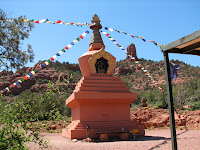



Of all the natural wonders we have seen on this trip so far, the Grand Canyon is the oddest. Maybe it’s the fact that you don’t see it off in the distance as you arrive. Or even if you’re only 25 yards from the edge! When you do finally see it, perhaps it is too immense to comprehend. The light, the angles, the strata, the depth, the width are all amazing, but there seems to be a void. Your energy extends into the canyon, but it is hard to feel energy coming up from the canyon.
The above was written after two days of viewing the canyon at various perspectives and times of day from the rim above. On our third day we descended below the rim on the South Kaibab Trail. As you leave the rim your perspective slowly starts to change. The colors grow more intense and there does seem to be an energy flow or pull. The way down is steep with switchbacks and ridge trials. The canyon beckons you to go further and further promising a better view just ahead. There are great views as you descend and the pull of gravity and energy toward the center of the canyon is palpable.
After 3 miles and 2040 feet of descent we reached Skeleton Point, our day hike turn around. We were in the middle (not the bottom) of the canyon (see picture). The way back up is steep, but we kept a slow steady pace and it only took 50% longer going up, rather than the 100% they tell you to allow (probably because we were so slow coming down). As you climb you can feel the energy (or is it just gravity) pulling you back down. Even after having been into the canyon, when you step back onto the rim, it is amazing how distant the canyon feels when you are just a few feet from the rim.
What we usually miss when we look and walk into the Canyon is the River. You get small glimpses of the river and the river seems distant, and a relatively minor part of the experience. But, in reality, it is all about the RIVER. The river is what has created the space, the river has literally carried away the mass of the earth, and perhaps it is the river that is sweeping away or holding the energy of the canyon. The wind comes and goes, the sun rises and sets, the rain and resulting cascades are usually short lived, but the River has been constant and relentless for millions of years. The canyon did not open up like some giant fissure. The earth was carried away grain by grain, second by second, every minute of every hour, of every day, of every year. The mighty ocean can pound relentlessly on a beach, but miraculously and harmoniously it seems to bring and take almost equal measures of sand. This river just seems to take…..
We are taught in school that rivers bring water from mountains to the plains, and that silt from the mountains gets deposited as rich soils during spring floods. This river, the Colorado, is a sculptor not a farmer. This river and its tributaries carve amazing canyons, cliffs, mesas, monoliths, gorges and serpentines in the rocks of Utah and Arizona. These features are not fertile ground for crops and cities, but they are very fertile inspiration for the spirit, imagination and soul. And, like fine art, there is something about rock sculpted by wind and water that goes right to your heart, at the same time it is delighting your senses and intriguing your mind.













































